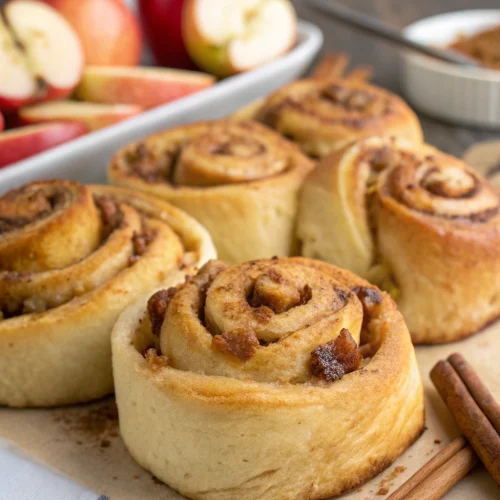
Overnight Apple Cinnamon Rolls
These gooey apple cinnamon buns combine the comfort of homemade bread with the sweet-tart flavor of fresh apples and warming cinnamon—all while fitting into your busy schedule. The overnight proofing not only saves you precious morning time but actually enhances the flavor development, creating a more complex and satisfying treat.
Equipment
- 9x13-inch Baking Dish
- Rolling Pin
- Mixing Bowls
- Stand Mixer (optional)
Ingredients
For the Dough
- 4 cups all-purpose flour substitute up to 1 cup with whole wheat flour for added nutrition
- 1/4 cup granulated sugar or coconut sugar for a caramel-like flavor
- 2 1/4 tsp active dry yeast 1 packet
- 1 tsp salt
- 1 cup warm milk about 110°F; almond or oat milk works for dairy-free
- 1/3 cup unsalted butter melted (or coconut oil)
- 2 large eggs room temperature (flax eggs work for vegan option)
For the Apple Filling
- 3 medium apples peeled and finely diced (Honeycrisp or Granny Smith)
- 1/2 cup brown sugar packed (or coconut sugar)
- 2 tbsp ground cinnamon
- 1/4 tsp freshly grated nutmeg
- 2 tbsp unsalted butter melted
- 1 tbsp cornstarch helps absorb excess moisture from the apples
For the Cream Cheese Glaze
- 4 oz cream cheese softened (or dairy-free alternative)
- 2 tbsp unsalted butter softened
- 1 1/2 cups powdered sugar
- 1/2 tsp vanilla extract
- 2-3 tbsp milk to desired consistency
Instructions
- In a large mixing bowl, combine 2 cups of the flour with the sugar, yeast and salt. In a separate microwave-safe bowl, warm the milk to about 110°F (just warm to the touch, not hot), add the melted butter, then whisk in the eggs. Pour this wet mixture into the dry ingredients and stir until combined.
- Add the remaining flour gradually, stirring until the dough forms a soft ball. Turn onto a floured surface and knead for 5-7 minutes until smooth and elastic. The dough should spring back when lightly pressed with your finger.
- Place the dough in a lightly greased bowl, cover with plastic wrap or a damp towel, and let rise in a warm place for about an hour, or until doubled in size.
- While the dough rises, make your filling. Toss the diced apples with brown sugar, cinnamon, nutmeg, and cornstarch. The cornstarch is crucial here—it will absorb excess moisture from the apples during baking, preventing soggy rolls.
- After the first rise, punch down the dough and roll it out on a floured surface into a large rectangle, approximately 18x12 inches. Brush the surface with melted butter, then evenly spread the apple filling mixture, leaving a 1-inch border along one long edge.
- Starting with the long edge (opposite from the border), tightly roll the dough into a log. Pinch the seam to seal. Using unflavored dental floss or a sharp knife, cut the log into 12 equal pieces, each about 1.5 inches thick.
- Arrange the rolls in a greased 9x13 inch baking dish, spacing them evenly. Cover tightly with plastic wrap and refrigerate overnight (8-12 hours).
- The next morning, remove the rolls from the refrigerator and let them sit at room temperature for 45-60 minutes to take the chill off. Preheat your oven to 350°F and bake for 25-30 minutes, until golden brown.
- While the rolls are baking, beat together the cream cheese and butter until smooth. Add powdered sugar and vanilla, mixing until combined. Add milk gradually until you reach your preferred consistency.
- Let the rolls cool for 5-10 minutes before spreading the glaze over the warm (not hot) rolls. This allows the glaze to partially melt into the crevices while still maintaining some thickness on top.
Notes
For a maple-apple flavor profile, substitute 1 tablespoon of the milk with pure maple syrup in your glaze.
Using a thermometer to check your milk temperature is crucial—too hot and you'll kill the yeast, too cool and it won't activate properly. The perfect 110°F feels like warm bathwater on your wrist.
For perfectly even rolls without squishing, slide a piece of dental floss under the roll, cross the ends over the top, and pull tight to slice through cleanly.
Nutrition
Calories: 340kcalCarbohydrates: 54gProtein: 6gFat: 12gSaturated Fat: 7gCholesterol: 55mgSodium: 220mgFiber: 2gSugar: 28g
Tried this recipe?Let us know how it was!